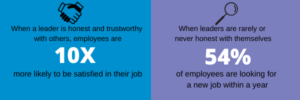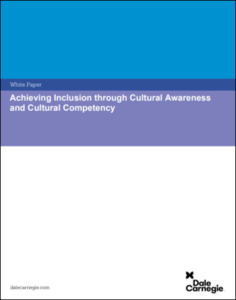With research showing that over the span of their career, the average person spends nearly 116,000 hours at work, it should be no surprise that corporate culture, no matter the size of your business is important.
As businesses rebuild post pandemic, they have been forced to address retaining talent to combat the great resignation. This has meant looking at everything from culture to flexible ways of working, how they engage with employees and of course overarching all this, the effectiveness of the leadership team. An individual’s sense of belonging massively impacts productivity and the bottom line, so ensuring that the workplace is an inclusive environment is a priority for today’s leaders.
Effective leadership builds trust

A critical part of the effectiveness of a leader is how much the staff trust them. This trust in a relationship is a “fundamental requirement… (In) protecting… culture “. During the pandemic, when many people felt genuine fear about entering the work environment, leaders needed to be seen to be creating a safe environment. It is likely that they would have relied upon that basis of trust existing within their company culture and team relationships pre-pandemic. It’s during a crisis or adversity that our relationships are tested, and the measure of leadership is often shown in challenging situations such as the COVID-19 pandemic.
How an inclusive environment impacts productivity
When a workplace has a strong inclusive culture, then it is likely staff are happier and more engaged. There is a wealth of data that suggests happier employees will be more productive and focused. Individuals relate to themselves as part of the bigger picture which includes the company’s mission and goals.
When individuals feel included, their sense of belonging both to their team and the business increases. This in turn means they are more motivated and will contribute to larger company goals.
Inclusion refers to the behaviours in the workplace that make people feel welcome and accepted. When individuals feel they can be their authentic selves at work this has a direct impact on their performance and a sense of belonging. When businesses have a strong culture of communication and a space that acknowledges our diversity, they can create an inclusive environment.
The difference between inclusion and belonging
In simple terms, inclusion relates to behaviour in the workplace, and belonging pertains to the feeling and emotions around being part of an organisation. In a recent article in Forbes entitled How any businesses can create a culture of belonging in the workplace it discusses four elements that demonstrate belonging at work:

The Harvard Business Review also discusses building a culture of belonging in our workplace and the challenges that our ways of working in the past two years have thrown up. There is no doubt that a shift away from in-person interactions, video calls and working from home have impacted our sense of belonging. Companies who have employee engagement at the top of their agenda will certainly recover but the feeling of belonging in your workplace can only come about when it is built on a foundation of inclusivity.
The challenges of creating an inclusive environment with hybrid working
How do you build an inclusive environment and lead effectively when many of your staff are not physically present together? A hybrid working model arguably works for those juggling family commitments but there is of course the negative side of those employees forced into remote working and leaders having to support feelings of isolation and fragmentation that have a mental health implication. In an article entitled ‘Hybrid work making it fit with your diversity, equity and inclusion strategy’, McKinsey shows data on underrepresented groups that showed a strong preference for hybrid work:

Inclusivity in practice
When considering diversity in the modern workplace Dale Carnegie’s Director of Research and Thought Leadership writes that
Diversity cannot be forced or manufactured; it must be learned and practised until it permeates our very culture “.
What this means is that creating an inclusive environment must be thought through and not simply a box-ticking exercise. This is about top-down inclusivity that builds a culture that starts with an effective and diverse leadership team.
Dale Carnegie training is underpinned by developing a people first culture and creating a fully inclusive environment that works on a one-for-one basis and not a one-for-all approach. As leaders it is our job to recognise the potential of our people and bring this talent through for the long-term success of our businesses. This requires leaders to understand how to have more empathy, balanced with still making sure performance is where it needs to be.
Useful Resources



